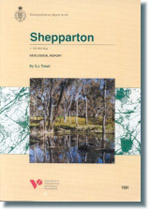GSV Report 88 - Shepparton 1:100 000 map geological report
 |
| |||||||||||||||||||||||||||||
Product description:Download The downloadable version of this report is supplied in PDF format (8.3MB). Abstract The main features of the Shepparton 1:100 000 geological map are the abandoned river courses ("prior streams") which cover the Riverine Plain. They have been mapped using aerial photographs and they show a series of successive positions of the major rivers across the plains. Older rocks only protrude through the plain in a few places on the southern boundary of the map. The area is situated on the southeastern corner of the Murray Basin and it has been dominated by fluviatile sedimentation since the Early Tertiary. Up to 250 metres of Tertiary and Quaternary sediments fill the ancestral valley of the Goulbum River. These comprise three units: the carbonaceous sand and clay of the Early to Mid Tertiary Renmark Group, gravel of the Mid to Late Tertiary Calivil Formation and clay and sand of the Late Tertiary to Quaternary Shepparton Formation. The Riverine Plain represents the depositional surface of the present day river systems. Various Palaeozoic rocks subcrop beneath the fill of the Murray Basin. The youngest of these are flat-lying Permian (and possibly Late Carboniferous) mudstone and pebbly mudstone deposited in marine and glacio-marine environments. These unconformably overlie folded and faulted Lower Palaeozoic rocks including Siluro-Devonian and Upper Ordovician marine sedimentary rocks, intrusive Late Devonian granites and ocean floor basalts and associated sediments of Cambrian age. The Mt Wellington Fault zone, a major bedrock structure passes across the mapsheet. It is a high angle thrust which has downfaulted Siluro-Devonian rocks on its southwestern side against Ordovician and Cambrian rocks to the northeast. Groundwater is an important resource as a source of irrigation water in the Shepparton area. The main aquifers which contain good quality water are shallow sands in the Shepparton Formation and the deeper Calivil Formation northeast of Numurkah. Many aquifers on the other hand contain saline groundwater which is often unusable. High watertables caused by irrigation and removal of native forests have resulted in the major environmental problems of waterlogging and soil salinity. Bibliographic reference Tickell, S.J., 1991. Shepparton 1:100 000 map geological report. Geological Survey of Victoria Report 88. Related products:
| ||||||||||||||||||||||||||||||



